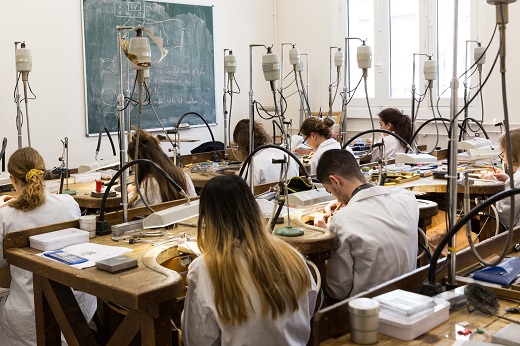|
|
What’s New at World’s Oldest Jewelry School
What is the Haute École de Joaillerie doing to meet the demands of the 21st century? Bernadette Pinet-Cuoq, its president, shares her vision.
Jan 1, 2020 4:37 AM
By Marie Chabrol
|
|
|

RAPAPORT... Paris’s Haute École de Joaillerie (HEJ) is the oldest jewelry school in the world. Founded by the French jewelry industry in the 19th century, it recently celebrated its 150th anniversary. Several major jewelry houses, including Boucheron and Mellerio dits Meller, have been involved with the HEJ from the start. At 58 Rue du Louvre, the school works together with the French Jewelry Syndicate (UFBJOP), the organization that created it, to secure the future of what has become an internationally recognized trade.
Bernadette Pinet-Cuoq is the school’s president, as well as deputy president of the UFBJOP.
How would you describe the role of French jewelry in a worldwide context?
French jewelry is carried by major luxury groups that are mostly French, and achieves EUR 5.3 billion in exports. We have a large production capacity, and therefore a need for training. Jewelry has been part of French history for several centuries, [and] it is strengthening and evolving to adapt to international issues [and changes]. The UFBJOP is at the heart [of this dynamic environment], supporting companies in this march toward competitiveness. Our trade union was the first professional organization to join the Responsible Jewellery Council (RJC).
What are the main challenges the high-jewelry industry is facing?
High-end jewelry supports regular evolutions. The arrival of artificial intelligence (AI) with additive manufacturing [a technology that 3D-prints precious metals] must be accompanied [by training and support], because it will require substantial investments. There are also very important issues of corporate social responsibility (CSR), with necessary changes in the supply chain and materials’ traceability. Major international brands have their most beautiful pieces made in France, so we must remain at the forefront to maintain this dynamism.
How has the teaching at HEJ evolved to reflect the new needs of the market?
We initiate a permanent dialogue between [jewelry] houses and the future professionals our current students will be.... We teach jewelry through manufacturing, and we train technicians. But creation is never far away, infusing the school’s workshops. Houses mainly ask us [to train] jewelers with bench experience but computer-aided design (CAD) practice. Block release training [in which students work in the field in tandem with their studies] interests both students and companies. We have just opened two training centers: Reims and Aix-en-Provence. Our 12,000 hours of training are formalized, [with a written syllabus] to preserve the transmission of knowledge.
How are today’s students different from previous generations?
Young people start now often after their baccalaureate [at the end of high school]. We have almost no more young people who arrive after the 10th [the final year of secondary school, when some take on apprenticeships instead of continuing to high school], and we regret it. Here, patience is necessary, as are dexterity and humility. Students have to be curious and open-minded, because this business is now evolving very quickly.
Are there new professions in the industry?
Definitely CAD developments. In addition, recent positions [have been created to deal with] responsibility and traceability. The industrial evolution of jewelry brings new skills [and] digital-control tools. We see houses recruiting engineers from Centrale Paris, PhD students in material science. We must therefore build bridges in the jewelry ecosystem. Also, we are unveiling an MBA in jewelry production management, [which will launch] in January 2020.
Are some jobs about to die out?
Our business has about 20 [fields of] know-how. Some jobs are necessarily rarer than others. We must [work to preserve them] to be able to answer specific needs: hand engraving, enamel, lacquer and polishing are specialties that require [our] particular attention.
How does HEJ envision the future?
We have to stick to the companies’ needs. We initiated professional certificates to train operators, we created a bachelor’s in design that we will extend to a master’s. We have just initiated the Technea project, which makes [design] students work together with student [bench] jewelers — the same way [it works] in a company, where a project manager has to follow jewels from the drawing to the delivery, with the risk that implies, and you have to manage technical challenges, time management, etc. September 2020 will see the creation of a bachelor’s in digital jewelry. Finally, we are equipping ourselves, through the Île-de-France region [with its Additive Factory Hub project] and [jewelry supplier] Cookson-CLAL, with an additive manufacturing machine. We are beginning to train our students in this technology, which will change our industry.
This article was first published in the November issue of Rapaport Magazine.
Image: Inside the Haute École de Joaillerie workshop. (Haute École de Joaillerie)
|
|
|
|
|
|
|
|
|
|
Tags:
Bernadette Pinet-Cuoq, boucheron, French Jewelry Syndicate, Haute École de Joaillerie, HEJ, Marie Chabrol, Mellerio dits Meller, Rapaport News, Responsible Jewellery Council, RJC, UFBJOP
|
|
|
|
|
|
|
|
|
|
|

|
|